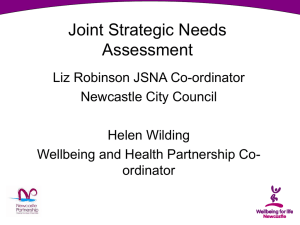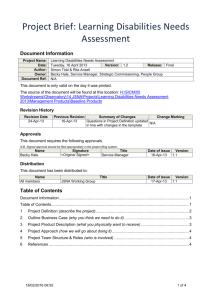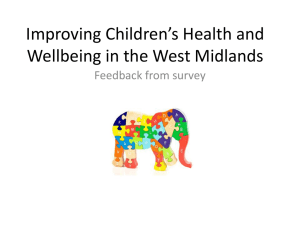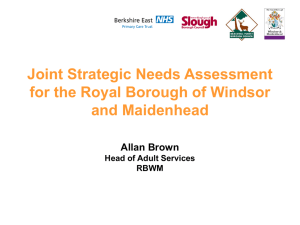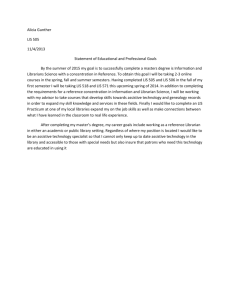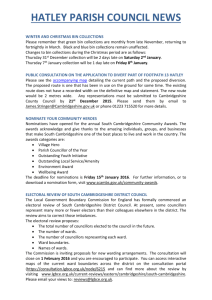JSNA Best Practice Cambridge Summary Report
advertisement
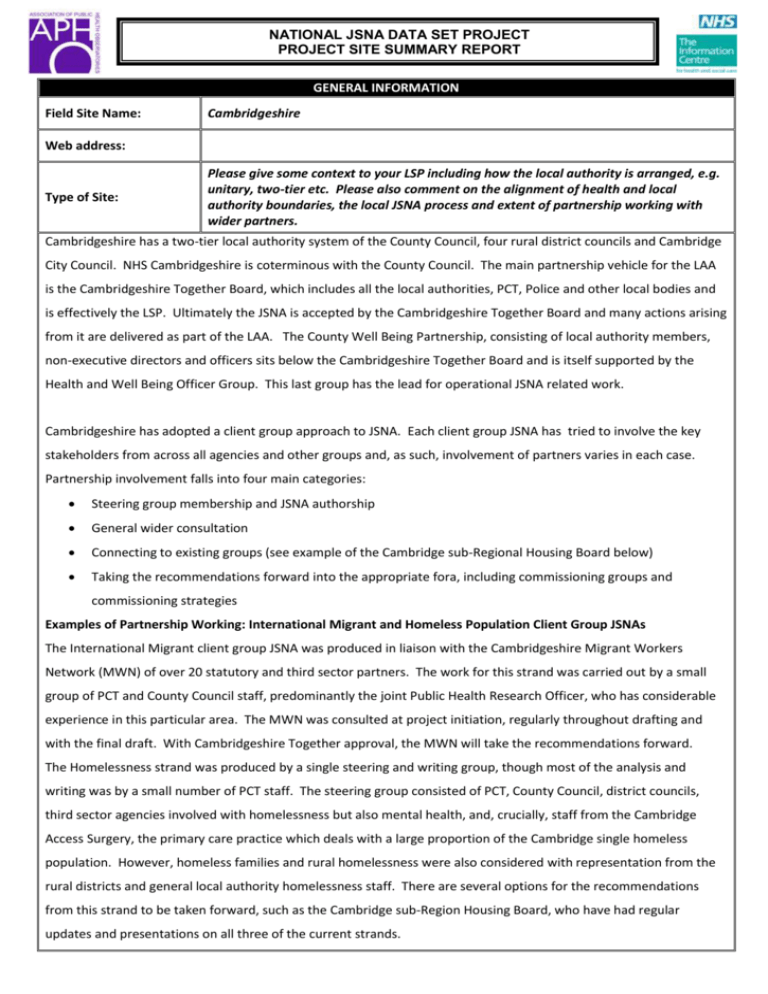
NATIONAL JSNA DATA SET PROJECT PROJECT SITE SUMMARY REPORT GENERAL INFORMATION Field Site Name: Cambridgeshire Web address: Type of Site: Please give some context to your LSP including how the local authority is arranged, e.g. unitary, two-tier etc. Please also comment on the alignment of health and local authority boundaries, the local JSNA process and extent of partnership working with wider partners. Cambridgeshire has a two-tier local authority system of the County Council, four rural district councils and Cambridge City Council. NHS Cambridgeshire is coterminous with the County Council. The main partnership vehicle for the LAA is the Cambridgeshire Together Board, which includes all the local authorities, PCT, Police and other local bodies and is effectively the LSP. Ultimately the JSNA is accepted by the Cambridgeshire Together Board and many actions arising from it are delivered as part of the LAA. The County Well Being Partnership, consisting of local authority members, non-executive directors and officers sits below the Cambridgeshire Together Board and is itself supported by the Health and Well Being Officer Group. This last group has the lead for operational JSNA related work. Cambridgeshire has adopted a client group approach to JSNA. Each client group JSNA has tried to involve the key stakeholders from across all agencies and other groups and, as such, involvement of partners varies in each case. Partnership involvement falls into four main categories: Steering group membership and JSNA authorship General wider consultation Connecting to existing groups (see example of the Cambridge sub-Regional Housing Board below) Taking the recommendations forward into the appropriate fora, including commissioning groups and commissioning strategies Examples of Partnership Working: International Migrant and Homeless Population Client Group JSNAs The International Migrant client group JSNA was produced in liaison with the Cambridgeshire Migrant Workers Network (MWN) of over 20 statutory and third sector partners. The work for this strand was carried out by a small group of PCT and County Council staff, predominantly the joint Public Health Research Officer, who has considerable experience in this particular area. The MWN was consulted at project initiation, regularly throughout drafting and with the final draft. With Cambridgeshire Together approval, the MWN will take the recommendations forward. The Homelessness strand was produced by a single steering and writing group, though most of the analysis and writing was by a small number of PCT staff. The steering group consisted of PCT, County Council, district councils, third sector agencies involved with homelessness but also mental health, and, crucially, staff from the Cambridge Access Surgery, the primary care practice which deals with a large proportion of the Cambridge single homeless population. However, homeless families and rural homelessness were also considered with representation from the rural districts and general local authority homelessness staff. There are several options for the recommendations from this strand to be taken forward, such as the Cambridge sub-Region Housing Board, who have had regular updates and presentations on all three of the current strands. NATIONAL JSNA DATA SET PROJECT PROJECT SITE SUMMARY REPORT Primary JSNA contact(s): Contact details: David Lea, Assistant Director of Public Trevor Baker, Research Manager, Cambs County Health Intelligence, NHS Council Cambridgeshire Tel: 01223 715302 Tel: 01480 372024 Mobile: Mobile: 07946302855 Email: Trevor.baker@cambridgshire.gov.uk Email: david.lea@cambridgeshire.nhs.uk PROJECT DETAILS Project overview, outcomes and output: Please give a summary of the project you chose to undertake and why. Briefly explain the methodology for the work you have carried out, detailing the outcomes and outputs available to share nationally. Summary of the project The Cambridgeshire project is about improving the local usage of JSNA data. There are three aspects of this: Increasing the level and effectiveness of project management Improving the promotion of JSNA results and access to the results Improving the flexibility and availability of the data to make effective use of that data for JSNA and other purposes The first of these is being dealt with by employing a JSNA Co-ordinator from November 2009. The JSNA Co-ordinator is also part of the solution to the second aspect regarding the promotion of the JSNA. The third, and the remaining part of the second, are being dealt with directly by the core of this project, which is to develop an electronic information portal for key elements of JSNA data. This may be built on later to produce a comprehensive Local Information System (LIS) for Cambridgeshire, bringing together the JSNA data with housing, economic and other information. Demographic information is a core element of this and is being used as a pilot data source for the initial development of the JSNA portal. For the National JSNA Dataset Project, best practice in developing a LIS has been investigated through evaluating other area’s LIS on the web, considering significant national studies of LIS and telephone questionnaires and visits to sites we identified as delivering LIS of the type we are seeking to develop. Reporting on this along with an exploratory data tool for Cambridgeshire constitutes progress to date for the JSNA National Project. Importantly, in developing the exploratory data tool there has been a focus on value for money, as best practice and the current economic climate lead us to see minimising cost as both possible and probably necessary in developing the full LIS. The Cambridgeshire project shares some common ground with the Surrey National JSNA project and elements of the fieldwork were carried out jointly. Reasons for carrying out this project The Cambridgeshire approach to JSNA has a number of strengths, such as strong partnership working, well embedded work with local boards leading to a commitment from elected Members and partners, and detailed analysis of individual JSNA strands based on themes ranging from older people to homelessness. Inevitably, some weaknesses remain, the two most important being: the overall project management and co-ordination of the JSNA strands on a day to day basis; using the mass of data behind the JSNA strands to better effect and promoting the use of that data via enhanced accessibility and flexibility. NATIONAL JSNA DATA SET PROJECT PROJECT SITE SUMMARY REPORT Additionally increased accessibility will provide information analysts with more time to better support the JSNA by allowing concentration on analysis tasks, rather than continually providing relatively routine data held in the current MS Word and PDF JSNA reports. Using the data to better effect involves making the data easily accessible for use in the future, both for updating the JSNA and for other purposes – the principle of collecting data once and using it many times. Use for other purposes would include further analysis directly by and for NHS Cambridgeshire, but also for wider uses which will benefit NHS Cambridgeshire and Cambridgeshire County Council services. Methodology The methodology followed this approach: Project definition and revision. The revision was ongoing through the project to take account of what was feasible given the resources available, particularly public health staff having to prioritise work on swine flu. However, apart from the time table, the initial proposal still stands. Agreement with the Surrey partnership over approach to and division of the work. A short literature review and a web based evaluation of LIS sites. This led to identification of best practice LIS/observatories and a general overview of the possibilities and some general strengths and weaknesses of the LIS approach itself and of the various approaches taken by different areas. Structured telephone interviews with key staff working on the identified best practice LIS using a common questionnaire agreed between Cambridgeshire and Surrey. This led to identification of the most appropriate sites to visit and an insight into the technical, organisational and procedural elements required for a good LIS. Site visits to four sites including a demonstration in each case. This allowed further exploration of the technical and organisational elements and how they impacted on the final LIS, its appearance, ease of use to extract and update data, flexibility and other factors. In parallel to this, in Cambridgeshire the first set of core data (demography) was defined. After completion of the visits, in Cambridgeshire the exploratory data tool was built using that core data. This approach supported the following outputs: A summary report on the work to identify best practice in producing an LIS to support JSNA (rather than a full review of LIS/observatories). The site questionnaire and visit outputs and analysis should enable other areas to quickly assess some of the leading LIS in the country and relate them specifically to JSNA support. An exploratory data tool. Demography is a core data set for the JSNA, and for other elements of the proposed comprehensive Cambridgeshire LIS. Therefore the exploratory data tool concentrates on demography. The benefit of the data tool nationally is as an example of a value for money approach to part of an LIS. The report will make it clear that one useful approach to developing an LIS is to fit together various bespoke or proprietary applications. What worked well? The approach to investigating LIS and JSNA portals funnelled down well from investigating a number of sites at a high level to the mid level of telephone interviews to the low level of site visits. Best practice sites were pleased to share their experience and to learn what others were doing. The questionnaire and site interviews appeared to work well in that we were able to explore the technical approach alongside the organisational and procedural approaches. It also worked well in ensuring a common approach by interviewers while leaving flexibility to explore some individual aspects of a LIS. Some aspects of the partnership worked well with Surrey, though inevitably that meant that decision making was slower than it would have been otherwise. The partnership was very informal, for example there was no necessity for any documentation. The self-applied pressure not to delay each other was probably beneficial, as was the division of work in terms of economies of scale for ourselves and the LIS sites we contacted. NATIONAL JSNA DATA SET PROJECT PROJECT SITE SUMMARY REPORT What didn’t work well? The project was carried out in short bursts of work in between other priorities. The problems with this sort of approach are well documented - it is inefficient. We might have been able to produce a more thorough analysis and develop the data model behind the exploratory data tool more comprehensively, given more time to work on this in sustained blocks of time. The governance and partnership structure for the JSNA was being reviewed and revised during the course of the project and this meant that decision making authority was largely devolved to those conducting the project. This can be overcome, as the new structures are now established, but it caused difficulties in the conduct of the project and potentially in the local penetration of the project outputs. What would you do differently? Ideally set aside more dedicated time/resources for the project at the outset. , Practically, recognise the time constraints and set more realistic goals at inception rather than revising the project definition throughout the project. Our initial brief was too ambitious given available resources and other priorities. Perhaps we should have taken on additional resource using the funds available rather than saving/using these for the technical aspects of the portal’s development. The organisational, cultural and technical complexities involved in developing a sustainable and well-used LIS are considerable and more time taken to explore and address these aspects initially may have been useful. However, our more detailed awareness of these complexities from the site research will help in the future. What barriers did you have to overcome? Public health staff were pulled off other work to deal with Swine Flu, with one knock on effect being the build up of other work aside from this project. The major problem was the effects caused by time taken up on Swine Flu for two key individuals. Firstly, on carrying out the actual work; secondly on raising the profile and allowing a higher level of priority. Organisationally this project has not had as high a profile as it should have. The impact of Swine Flu workload on key public health staff resulted in the project not being taken through the governance structures such as the Health and Wellbeing Officer Group as would have occurred normally. However, the Cambridgeshire Together Board has recently expressed an interest in bringing the data from many sources together around JSNA. This project is, and always was, the first stage of doing that. The Health and Wellbeing Officer Group will be focussing on JSNA at its November meeting which will give an opportunity to raise the profile of this project, and the Community Wellbeing Partnership (Members and non-executives) will receive a paper on JSNA developments in December. Swine flu and its impact on the evolving JSNA governance approach meant that decisions were taken in more isolation than was ideal. This felt like a barrier to the proper development of the work, but we continued with the work and so in some ways we overcame this. It means more work later in publicising the project and then organising any changes to the outputs going forwards. Looking ahead how has your JSNA work helped to prepare you for the new policy landscape of "Total Place", QIPP, "Personalisation" and "World Class Commissioning"? The JSNA itself should work well for Total Place as the Cambridgeshire approach brings together the different strands in an overarching JSNA. Bringing together the diverse data around JSNA in one place using the data tool then LIS will be useful for all analyses relating to Total Place and this is reflected in the Cambridgeshire Together interest. The situation is similarly for the “personalisation” agenda. There is considerable consultation taking place in Cambridgeshire around personalisation and the secondary data analysis carried out in parallel to the primary consultations will benefit immediately from the data tool. That benefit is likely to increase in future as the LIS develops through the NATIONAL JSNA DATA SET PROJECT PROJECT SITE SUMMARY REPORT JSNA-focussed then the comprehensive Cambridgeshire version. The JSNA is already used in this process. The JSNA is core to the WCC agenda broadly and very specifically in terms of the WCC competencies related to Knowledge Management and Partnerships. The project has helped to enhance the PCT’s approach to Knowledge Management by assessing and developing an improved and modernised delivery tool for JSNA information. It also provides an evidence base for the potential further development of a partnership LIS along with the County Council and hopefully other partners. What concerns do you have about making your JSNA useful for this new context? A general point is the limitations to the use of data and information in the JSNA for very specific uses which it is not designed for. To illustrate this: Total Place can look at small as well as large geographies. Ward level data or below is often requested in Cambridgeshire. Much of the data and information in JSNA and other sources such as the Place Survey and the Strategic Housing Market Assessments is not robust at small area level (and never could be). While carefully designed analyses such as comparing the 20% most deprived LSOA in Cambridgeshire against the 80% least deprived can be useful, it is difficult to see how the data can be brought to bear on a single small area. There is an analogous problem with the timing of data, particularly measures of public health over time, which make no sense to consider on an annual basis, or shorter period. ADDITIONAL INFORMATION Please provide any additional information you deem useful, and any other relevant comments and list attached documents, presentations and web-links. A summary findings report and individual LIS site reports and links will be added once they approved by the sites concerned. National Research and Tools to support LIS development: http://www.communities.gov.uk/publications/communities/localinformationsystems Cambs JSNA at http://www.cambridgeshire.nhs.uk/default.asp?id=656 Cambridgeshire Atlas (demography): http://map1.cambridgeshire.gov.uk/observe/Flash/population/PopGrowth01to21_2007Update/atlas.html Please return completed forms to renata.muncey@ic.nhs.uk Many thanks for completing this form and for your engagement and enthusiasm for the project!
